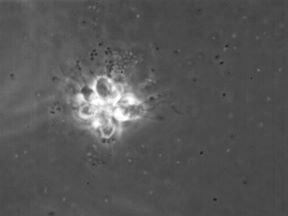Selective factors in the evolution of multi-cellularity

The evolution of multicellular animals from a unicellular ancestor represents a pivotal transition in life's history, and one of its greatest unsolved mysteries. Choanoflagellates (bacteria-eating protozoa that swim by undulating a flagellum) are the closest living relatives of animals. We have been using Salpingoeca rosetta, a unicellular choanoflagellate that can be induced to form multicellular colonies, as a model organism to study the evolution of multicellularity. For multicellularity to evolve, there must have been a selective advantage to being colonial, but since both unicellular and colonial choanoflagellates still exist today, there may be different environmental conditions under which single-celled or multicellular forms perform better. One important aspect of performance likely to affect choanoflagellate survival and reproduction is foraging (finding and capturing bacterial prey). Aquatic habitats can differ in the richness and patchiness of bacteria. We have been using S. rosetta to explore the functional consequences of being multicellular vs. unicellular, focusing on the physical mechanisms that determine foraging performance, which depends on (i) ability to find and retain position within patches of prey bacteria, and (ii) transport of prey in the flagella-produced water currents to the capture surfaces of the choanoflagellate. Protozoans, both unicellular and colonial, play an important role in aquatic food webs, so understanding the consequences of being uni- vs. multicellular to foraging performance in different habitats also has ecological significance. We are also studying how unicellular versus colonial choanoflagellates interact with different types of protozoan predators like those they would have encountered before muticellular animals evolved.
Selected references on this topic
- Roper, M., M. J. Dayel, R. E. Pepper, N. King, and M. A. R. Koehl. (2013) Cooperatively generated stresslet flows supply fresh fluid to multicellular choanoflagellate colonies. Phys. Rev. Lett. 110: 228104 DOI: 10.1103/PhysRevLett.110.228104.
- Mino, G. L., M. A. R. Koehl, N. King, and R. Stocker. (2017) Finding patches in a heterogeneous aquatic environment: pH-taxis by the dispersal stage of choanoflagellates. Limnol. Oceanogr. Lett. 2: 37-46 doi:10.1098/rsif.2015.0850.
- Nguyen, H, M.A.R. Koehl, C. Oakes, G. Bustamante, L. Fauci (2019) Effects of cell morphology and surface attachment on the hydrodynamic performance of unicellular choanoflagellates. J. Royal Society Interface 16: doi.org/10.1098/rsif.2018.0736
- Kumler, W.E., J. Jorge, P.M. Kim, N. Iftekhara, M. A. R. Koehl (2020) Does formation of multicellular colonies by choanoflagellates affect their susceptibility to capture by passive protozoan predators? Eukaryotic Microbiology 67: 555-565. doi: 10.1111/jeu.12808
- Koehl, M. A. R. (2020) Selective factors in the evolution of multicellularity in choanoflagellates. J. Exp. Zool. Part B: Molec. Devel. Evolution. doi: 10.1002/jez.b.22941
- Pepper, R. E., E. E. Riley, M. Baron, T. Hurot, L. T. Nielsen, M. A. R. Koehl, T. Kiørboe, A. Andersen (2021) The effect of external flow on the feeding currents of sessile microorganisms. J. Roy. Soc. Interface. 18: 20200953. doi.org/10.1098/rsif.2020.0953
- Chin, N.E., T.C. Wu, J.M. O'Toole, K. Xu, T. Hata, and M. A. R. Koehl (2022) Formation of multicellular colonies by choanoflagellates increases susceptibility to capture by amoeboid predators. Journal of Eukaryotic Microbiology. 00,e12961. doi.org/10.1111/jeu.12961
- Nguyen, H., Ross, E., Cortez, R., Fauci, L., and Koehl, M. A. R. (2023). Effects of prey capture on the swimming and feeding performance of choanoflagellates. Flow 3: E22 doi:10.1017/flo.2023.16
Unpublished data - choanoflagellate swimming
- We have posted some of our unpublished data on choanoflagellate swimming and feeding at this link.
Links to Specific Topics
- Fluid dynamics of hairy little legs
- Microscopic organisms swimming in turbulent flow/Larval Settlement
- Fluid dynamics of odor capture by olfactory antennae
- How do benthic organisms withstand and utilize moving water?
- Biomechanics of hydrostatic skeletons
- Biomechanics of morphogenesis
- Evolution of novel function / Consequences of body size
- Fluid dynamics of animals at intermediate Re
